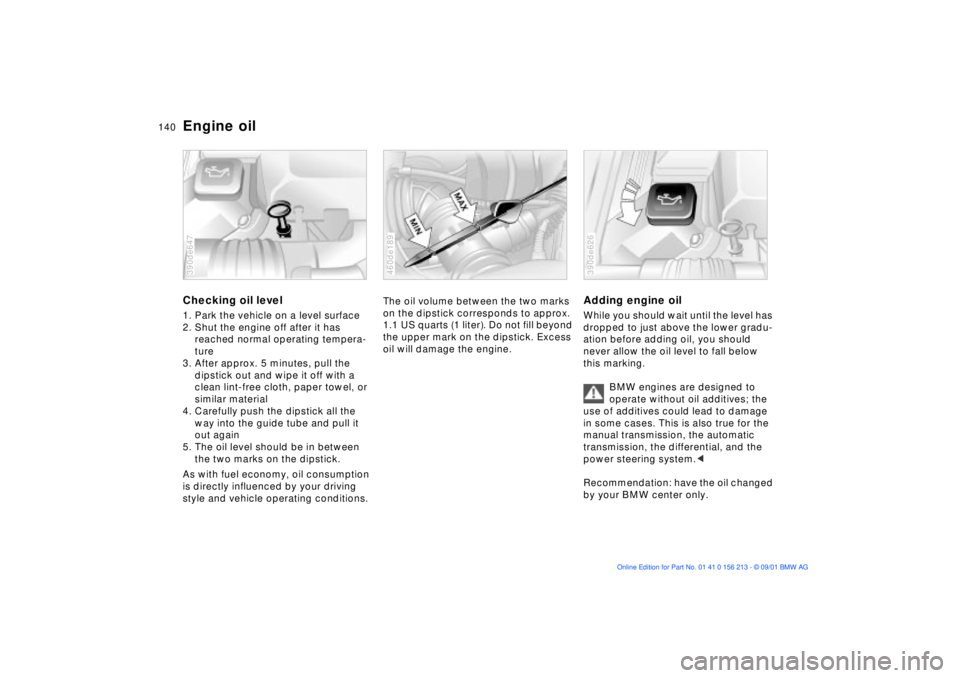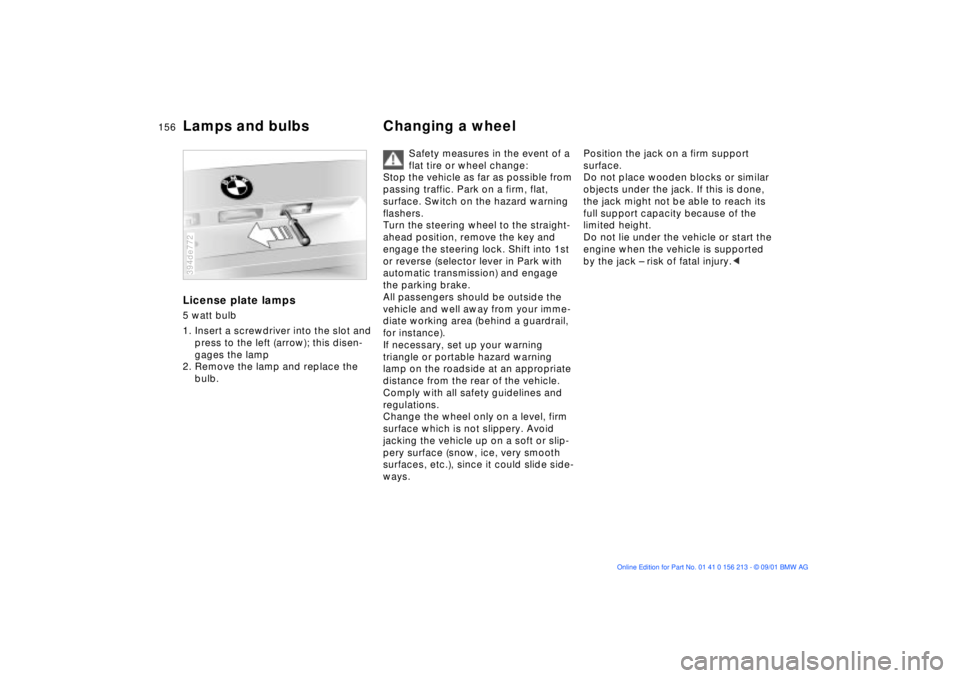2002 BMW 540I SEDAN transmission
[x] Cancel search: transmissionPage 132 of 186

132n
Brake systemBrake fluid level If the brake fluid level is too low and
brake pedal travel has become notice-
ably longer, there may be a defect in
one of the brake system's hydraulic
circuits.
Proceed to the nearest BMW
center. Higher brake application
pressure may be necessary under these
conditions, and the vehicle may exhibit
a slight tendency to pull to one side
when the brakes are applied. Braking
distances may also be longer. Please
remember to adapt your driving style
accordingly.<
Disc brakesLimited vehicle use, extended periods
with the vehicle parked or in storage,
and operating conditions in which
braking is restricted to gentle, low-
pressure applications will all increase
the tendency for corrosion to form on
the rotors; this is often accompanied by
a simultaneous accumulation of
contamination on the brake pads. The
pads must exert a certain minimal level
of pressure against the rotors for the
disc brakes' inherent self-cleaning
effect to remain effective; the pressure
available under the above conditions
may not provide adequate cleansing.
If the brake rotors are corroded, they
will tend to respond to braking with a
pulsating effect that even extended
brake applications will fail to cure.
When driving in heavy rain and on wet
roads it is a good idea to apply light
pressure to the brake pedal every few
miles. Monitor traffic conditions to
ensure that this maneuver does not
pose a hazard to you or to other road
users. The heat generated in this
process helps dry the pads and rotors
to ensure that your brake system will
respond with undiminished efficiency
when you need it.When descending steep hills and
extended grades, downshift to a gear
that will allow you to continue safely
with only a minimal amount of braking.
By minimizing the loads placed on the
brake system, this strategy helps
ensure that optimal brake system
response will remain available at all
times.
Do not coast with the clutch
depressed or with the transmission
or selector lever in Neutral. Do not coast
with the engine shut off. The engine
provides no braking effect when the
clutch is depressed and there is no
power-assist for braking or steering
when the engine is not running.
Never allow floor mats, carpets or any
other objects to protrude into the area
around the accelerator, clutch and brake
pedals and obstruct their movement.<
Brake pads
For your own safety: use only
brake pads that BMW has
approved for your particular vehicle
model. BMW cannot evaluate non-
approved brake pads to determine if
they are suited for use, and therefore
cannot ensure the operating safety of
the vehicle if they are installed.<
Page 140 of 186

140n
Engine oilChecking oil level1. Park the vehicle on a level surface
2. Shut the engine off after it has
reached normal operating tempera-
ture
3. After approx. 5 minutes, pull the
dipstick out and wipe it off with a
clean lint-free cloth, paper towel, or
similar material
4. Carefully push the dipstick all the
way into the guide tube and pull it
out again
5. The oil level should be in between
the two marks on the dipstick.
As with fuel economy, oil consumption
is directly influenced by your driving
style and vehicle operating conditions.390de647
The oil volume between the two marks
on the dipstick corresponds to approx.
1.1 US quarts (1 liter). Do not fill beyond
the upper mark on the dipstick. Excess
oil will damage the engine.460de189
Adding engine oilWhile you should wait until the level has
dropped to just above the lower gradu-
ation before adding oil, you should
never allow the oil level to fall below
this marking.
BMW engines are designed to
operate without oil additives; the
use of additives could lead to damage
in some cases. This is also true for the
manual transmission, the automatic
transmission, the differential, and the
power steering system.<
Recommendation: have the oil changed
by your BMW center only.390de626
Page 156 of 186

156n
Lamps and bulbs Changing a wheelLicense plate lamps5 watt bulb
1. Insert a screwdriver into the slot and
press to the left (arrow); this disen-
gages the lamp
2. Remove the lamp and replace the
bulb.394de772
Safety measures in the event of a
flat tire or wheel change:
Stop the vehicle as far as possible from
passing traffic. Park on a firm, flat,
surface. Switch on the hazard warning
flashers.
Turn the steering wheel to the straight-
ahead position, remove the key and
engage the steering lock. Shift into 1st
or reverse (selector lever in Park with
automatic transmission) and engage
the parking brake.
All passengers should be outside the
vehicle and well away from your imme-
diate working area (behind a guardrail,
for instance).
If necessary, set up your warning
triangle or portable hazard warning
lamp on the roadside at an appropriate
distance from the rear of the vehicle.
Comply with all safety guidelines and
regulations.
Change the wheel only on a level, firm
surface which is not slippery. Avoid
jacking the vehicle up on a soft or slip-
pery surface (snow, ice, very smooth
surfaces, etc.), since it could slide side-
ways.
Position the jack on a firm support
surface.
Do not place wooden blocks or similar
objects under the jack. If this is done,
the jack might not be able to reach its
full support capacity because of the
limited height.
Do not lie under the vehicle or start the
engine when the vehicle is supported
by the jack Ð risk of fatal injury.<
Page 164 of 186

164n
Towing the vehicle
The towed vehicle should always
be the lighter of the two vehicles.
If this is not the case, it is no longer
possible to control vehicle response.<
Tow-startingIt is not possible to start the engine of
vehicles equipped with an automatic
transmission by towing or pushing.
For instructions on jump-starting: refer
to page 162.
Never attempt to use your vehicle to
push another vehicle, since damage to
the energy-absorbing bumpers could
result.
Towing a vehicle with automatic
transmission1. Place the selector lever in position N
2. Towing speed:
Max. 45 mph (70 km/h)
3. Towing distance:
Max. 95 miles (150 km)
4. Leave the ignition key in position 1 to
ensure that the brake lamps, turn
signals, horn and windshield wipers
remain operative, and to prevent the
steering lock detent from engaging
5. Switch on the hazard warning
flashers (observe official regulations).
Find some means of identifying the
vehicle in tow, for instance, place a sign
or warning triangle in the rear window.
Make sure that the ignition key
remains in position 1 even when
the electrical system has failed to
prevent the steering lock from
engaging. The steering and brakes are
without power-assist when the engine
is off. This means that increased effort
is required for steering and braking.<
Towing with a commercial
tow truck>Do not tow with sling-type equipment
>Use a wheel-lift or flatbed carrier
>Please comply with applicable towing
laws.
Never allow passengers to ride in
a towed vehicle for any reason.< 380us124
Page 171 of 186

171n
OverviewControlsMaintenanceRepairsDataIndex
Weights Ð sedan
BMW 525i BMW 530i BMW 540i
Curb weight (with one person, ready for operation, full tank of fuel, options not included)
with manual transmission
with automatic transmissionlbs. (kg)
lbs. (kg)3,450 (1,565)
3,505 (1,590)3,494 (1,585)
3,549 (1,610)3,748 (1,700)
3,803 (1,725)
Approved gross vehicle weight
with manual transmission
with automatic transmissionlbs. (kg)
lbs. (kg)4,464 (2,025)
4,520 (2,050)4,509 (2,045)
4,563 (2,070)4,762 (2,160)
4,817 (2,185)
Approved front axle weight lbs. (kg)
2,138 (970)2,138 (970) 2,381 (1,080)
Approved rear axle weight lbs. (kg) 2,579 (1,170) 2,579 (1,170) 2,635 (1,195)
Approved roof load capacity lbs. (kg) 220 (100) 220 (100) 220 (100)
Never exceed either the approved axle weights or the gross vehicle weight.
Luggage compartment capacity cu ft (l) 16.2 (460) 16.2 (460) 16.2 (460)
Page 172 of 186

172n
Weights Ð sport wagon
BMW 525i BMW 540i
Curb weight (with one person, ready for operation, full tank of fuel, options not included)
with manual transmission
with automatic transmissionlbs. (kg)
lbs. (kg)3,682 (1,670)
3,715 (1,695)Ð
4,056 (1,840)
Approved gross vehicle weight
with manual transmission
with automatic transmissionlbs. (kg)
lbs. (kg)4,773 (2,165)
4,828 (2,190)Ð
5,093 (2,310)
Approved front axle weight lbs. (kg)
2,116 (960)2,381 (1,080)
Approved rear axle weight lbs. (kg) 2,844 (1,290) 2,910 (1,320)
Approved roof load capacity lbs. (kg) 220 (100) 220 (100)
Never exceed either the approved axle weights or the gross vehicle weight.
Luggage compartment capacity cu ft (l) 14.5 Ð 53.9 (410 Ð 1,525) 14.5 Ð 53.9 (410 Ð 1,525)
Page 173 of 186

173n
OverviewControlsMaintenanceRepairsDataIndex
Capacities
Notes
Fuel tank
Reservegal. (liters)
gal. (liters)approx. 18.5 (approx. 70)
approx. 2.0 (approx. 8) Ð BMW 525i, 530i
approx. 2.5 (approx. 10) Ð BMW 540iFuel specification: page 25
Windshield washer system
with headlamp washer system
Intensive cleaning systemquarts (liters)
quarts (liters)
quarts (liters)approx. 3.7 (approx. 3.5)
approx. 6.3 (approx 6.0)
approx. 1.1 (approx 1.0)For details: page 139
Cooling system including
heater circuitquarts (liters) 11.1 (10.5) Ð BMW 525i, 530i
12.7 (12.0) Ð BMW 540iFor details: page 142
Engine oil and filter change quarts (liters) 6.9 (6.5) Ð BMW 525i, 530i
7.9 (7.5) Ð BMW 540i"BMW High Performance
Synthetic Oil."
For details: page 141
Manual transmission, automatic
transmission and differentialÐ Ð Lifetime fluid, no fluid
change required
Page 176 of 186

Everything from A to ZA
ABS (Antilock Brake
System)20, 131
Accessories10
Activated-charcoal
filter112
Active seat52
Adaptive Transmission
Control (ATC)70, 73
Add
antifreeze142t
brake fluid143t
engine coolant142t
engine oil140t
washer fluid139t
Adjusting
backrest50
head restraints52
mirrors57
seats48
steering wheel56
temperature105, 109
thigh support50
Air conditioning104
Air distribution105, 109
Air outlets104, 107
Air pressure26t, 133
Air supply105, 109
Air vent104, 107 Airbags20, 58
Alarm system42
Anchorages to secure the
load126
Antifreeze, disposal142t
Antifreeze, radiator142
Antilock Brake System
(ABS)20, 131
Anti-theft alarm system42
Anti-theft protection34
Approved axle weight171
Approved gross vehicle
weight171
Aquaplaning131, 133
ASC+T (Automatic Stability
Control plus Traction)21
ASC+T/DSC (Automatic
Stability Control plus
Traction/Dynamic Stability
Control)97
Ashtray, front117
Ashtray, rear118
ATC (Adaptive Transmission
Control)70, 73
Attach vacuum cleaner118
AUC (Automatic
recirculated-air
control)110 Automatic climate
control107
removing condensation
from windows109
Automatic cruise control78
Automatic curb monitor55
Automatic rear window
cleaning77
Automatic recirculated-air
control (AUC)110
Automatic Stability Control
plus Traction (ASC+T)21
Automatic Stability Control
plus Traction/Dynamic
Stability Control (ASC+T/
DSC)97
Automatic
transmission20, 70
Automatic transmission with
Steptronic20, 73
Average fuel
consumption86
Average speed86, 94
Avoid false alarms43t
Avoiding unintentional
alarms44
B
Backrest, adjusting50
Backup lamps
bulb replacement154t
Battery160
care160t
charging160t
discharged162t
disposal160t
Belts53
Beverage holder117
Blower105, 109
BMW active seat52
BMW comfort seat51
BMW Maintenance
System144t
BMW Universal
Transmitter113
Bottle holder, refer to
beverage holder117
Brake fluid143
adding143
Brake hydraulic system19
Brake lamps, bulb
replacement154t
Brake malfunctions132